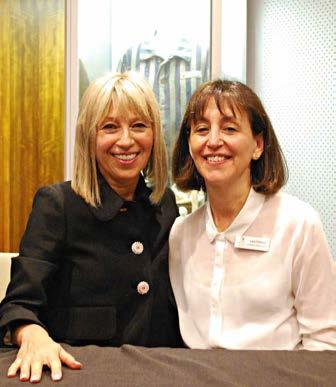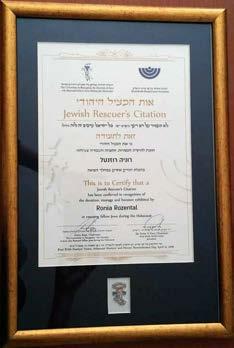
5 minute read
Anita Selzer
in conversation with Lisa Phillips
Anita Selzer is a Melbourne-based author who writes non-fiction for children and adults. Her book, titled I Am Sasha, was published recently. Here she is in conversation about the book with Lisa Phillips, the Jewish Holocaust Centre Education Director.
Advertisement

LP: Why did you decide to write this story?
AS: In 1994, before my grandmother passed away, she handed me a manila folder with Ioose Ieaf pages in it. In it she wrote, ‘The story of how your father and I survived the Holocaust is in this file. I want you to tell the world how we did. You are becoming a writer with a book already published. Please write and publish our story. Promise me.’ I wrote I am Sasha to honour her wish and leave my children a tangible record of their legacy. I would not have thought to write the story if she had not asked me. It was a part of my father’s life that he really did not want to discuss.
LP: You had your grandmother Larissa’s memoir and a short story written by your father. Could you tell us about what they contained, when they were written, and what other research you had to do to write I Am Sasha?
AS: The pages in Larissa’s memoir were written in blue biro, spanning the years of her life. While her mother tongue was Polish, the memoir was written in English, in post-war Melbourne. It focused on her family life, meeting and marrying my grandfather, losing him, and life during the war and postwar years.
In Melbourne in 1966, my father had typed a short piece about his life during the war entitled ‘A Magnificent Deception’. lt begins in 1941, describes various incidents that are recorded in my grandmother’s memoir, and mentions how he had survived disguised as a teenage girl. Dad had submitted this story for publication without success. I think the time was not right then, and his rendition did not include how he had felt or thought about being a teenage girl. What his writing told me, however, was that Dad wanted his story shared with a wider audience.
As I wanted readers to feel as if they were there on the journey with Sasha and Larissa, I had to do extensive research, so I gathered information about pre-war Poland, the Second World War, the Holocaust, other survivors’ experiences, and the places in which my father and grandmother had lived and visited.
LP: The historical detail is a strength of the book, which makes it an excellent educational resource. You describe the rich Jewish world that existed before the war; the death camps, which you refer to by name; the mobile Einsatzgruppen and their role in the destruction of the communities; the Jewish councils known as the Judenrat; the Warsaw Ghetto Uprising whose 75th anniversary we have recently marked; and you even had Sasha reading Janusz Korczak’s books for children. How did you decide what information to include and what to exclude?
AS: Initially, it was daunting to decide what information to include and exclude in the book. I wanted to write more than the story of my family’s survival, so it was important to include the historical context. I felt the need to paint the bigger picture of war and educate readers about it, especially for young adult readers, and adults who may not know much or anything about the Holocaust.
I wished there to be shades of light and dark in the book, to show love, kindness and hope, as well as the horror of war. Other themes in the text are racial and religious identity; gender identity; adolescence and puberty; racism, inhumanity and human rights; truth and deception; hiding; choice and chance; friendship and trust; cruelty; tolerance and acceptance; loss and displacement; and immigration. There are probably more themes woven through the text that I hope readers will enjoy discovering.
I wrote hoping that readers would have a visual experience –that they are able to see the story unfolding through the text. Above all, for me, I Am Sasha needed to be as authentic as possible. The memoir and photographs are primary sources
–historical evidence that authenticates both the story and moments in history. That is why I included excerpts from the memoir along with photographs. Sasha reading a book like Janusz Korczak’s work was also a conscious choice to include as an example of what was read by young people at that time.
I chose to exclude some historical information in telling the story of Sasha’s survival, Larissa’s early family life and her life with her husband, as I felt the focus needed to be on Sasha and his journey. That is why I wove the history seamlessly into the story, rather than having it stand out as a history lesson. I also felt that the text would have been too long had I written more detail about the war.
LP: What were some of the challenges you faced when writing I Am Sasha?
First, writing in the voice of a young boy who is telling a story was challenging, as I had not done this before. My preceding nine published books were in the area of Australian history and biography. Imagining Sasha’s feelings and thoughts was a second challenge, as I had never discussed these with my father. He did not talk about the war, only to say, ‘Every day I got after the war was a bonus because I was destined to die.’ I needed to imagine his thoughts and feelings. Perhaps raising two sons enlightened me somewhat about the psyche of an adolescent boy. And thirdly, finding the right publisher and ‘home’ for I am Sasha was a long road, which required faith and perseverance.
Originally, I wrote Saving Sasha in my grandmother Larissa’s voice in 2013. That was challenging because I had never written a novel before. A year later, I submitted the manuscript to publishers. Although there was considerable interest, I was not convinced that the offers made to me were the right ones, so at that stage I felt disheartened. Eventually, however, I was advised to re-write the story in Sasha’s voice and tell the story from his point of view. I did this with reluctance, but it was the right strategy, as the new manuscript was accepted by Penguin Books. I felt I had now found the right home for I Am Sasha, as the publishers understood the emotional resonance of the story.
LP: What m essages would you like those reading I Am Sasha to gain?
AS: Toler ance and acceptance of different races and cultures is an important message, along with the promotion of global peace, love and kindness. We need to remember that we are all the same, made of flesh, blood and bone. We also need to reflect and recall the inhumanity of Adolf Hitler and his regime and say ‘never again’.
I would like readers of I Am Sasha to understand that gender is not necessarily fixed, but rather can be fluid, enacted, practised and contested. Gender is part of a becoming and, to a large extent, a performance. As existential philosopher Simone de Beauvoir has said, ‘One is not born, but rather becomes a woman.’ And this is influenced by choice – like the reluctant, but lifesaving one made by Sasha as a teenager in I Am Sasha.
Jewish Rescuer Citation awarded to Ronia






